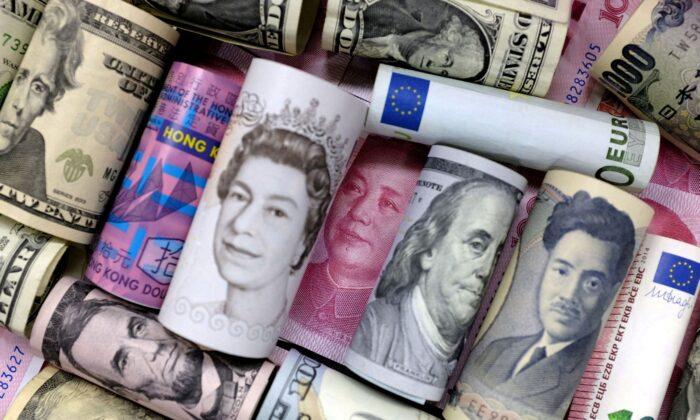LONDON—The dollar traded flat against major currencies on Friday ahead of a U.S. non-farm payrolls report expected to provide traders with further clues on the pace of the Federal Reserve’s policy normalisation.
The U.S. Dollar Currency Index, which measures the dollar against a basket of six peers, rose 0.1 percent to 94.338, last trading unchanged at 94.164.
“The dollar will trade soft into the payrolls,” said Neil Jones, head of FX sales, financial institutions at Mizuho Bank.
“The market is running long and reducing ahead of event risk in the face of mild pro-risk higher asset prices.”
The dollar gained 0.3 percent to 111.96 yen, and touched 111.975, the highest level this month, helped by higher Treasury yields, with the benchmark 10-year bond hitting 1.6010 percent for the first time since June 4.
Jones said he expected the yen to weaken to 115 yen per dollar by the end of December 2021. He said central bank divergence would remain in play as the world’s central banks hike rates while Japan remains on hold within a higher inflationary backdrop.
The euro consolidated around $1.1562, after weakening on Wednesday to a 14-month low of $1.1529.
The Federal Reserve has said it is likely to begin reducing its monthly bond purchases as soon as November and follow up with interest rate increases, potentially next year, as its turn away from pandemic crisis policies gains momentum.
The non-farm payrolls data, due at 1230 GMT on Friday, is expected to show continued improvement in the labour market, with a consensus forecast a Reuters poll of 500,000 jobs added in September, although estimates ranged from 250,000 to 700,000.
“A softer than expected NFP number would likely trigger some corrective activity in the USD if it raised doubts about the Fed’s tapering path, and/or the timing of the first Fed rate hike of the cycle,” said Jane Foley, head of FX strategy at Rabobank.
“However, until investors are comfortable again with the outlook for EM, we expect the USD to remain on the front foot, so would expect any correction to be fairly limited.”
Following the September Federal Open Market Committee meeting, Fed Chair Jerome Powell said the upcoming payrolls report need not be “a knock-out, great, super-strong” report to keep policy makers on track toward tapering, but it would need to be “reasonably good”.
Powell’s comment “should make markets more tolerant of a downside surprise in particular, and the balance of risks favours a positive USD reaction” to the jobs data, Adam Cole, chief currency strategist at RBC Capital Markets, wrote in a research note.
Meanwhile, the Australian dollar slipped back 0.2 percent to $0.7299, following a 0.55 percent surge on Thursday. It earlier touched $0.7324 for a second day running, the strongest level since Sept. 16.
The Aussie has made “a decent go at breaking higher,” but the test will be whether it can stay at about $0.7315 following several failed attempts this year, Rodrigo Catril, senior FX strategist at National Australia Bank in Sydney, wrote in a client note.
Sterling gained 0.1 percent to $1.3624, holding on to most of a 0.26 percent gain from Thursday, when new Bank of England Chief Economist Huw Pill said inflation pressures were proving stickier than initially thought, reinforcing expectations for a rate hike by February.
The Canadian dollar was little changed at C$1.2548 per greenback after earlier strengthening to a one-month peak of C$1.2534 on the back of rising oil prices.






Friends Read Free